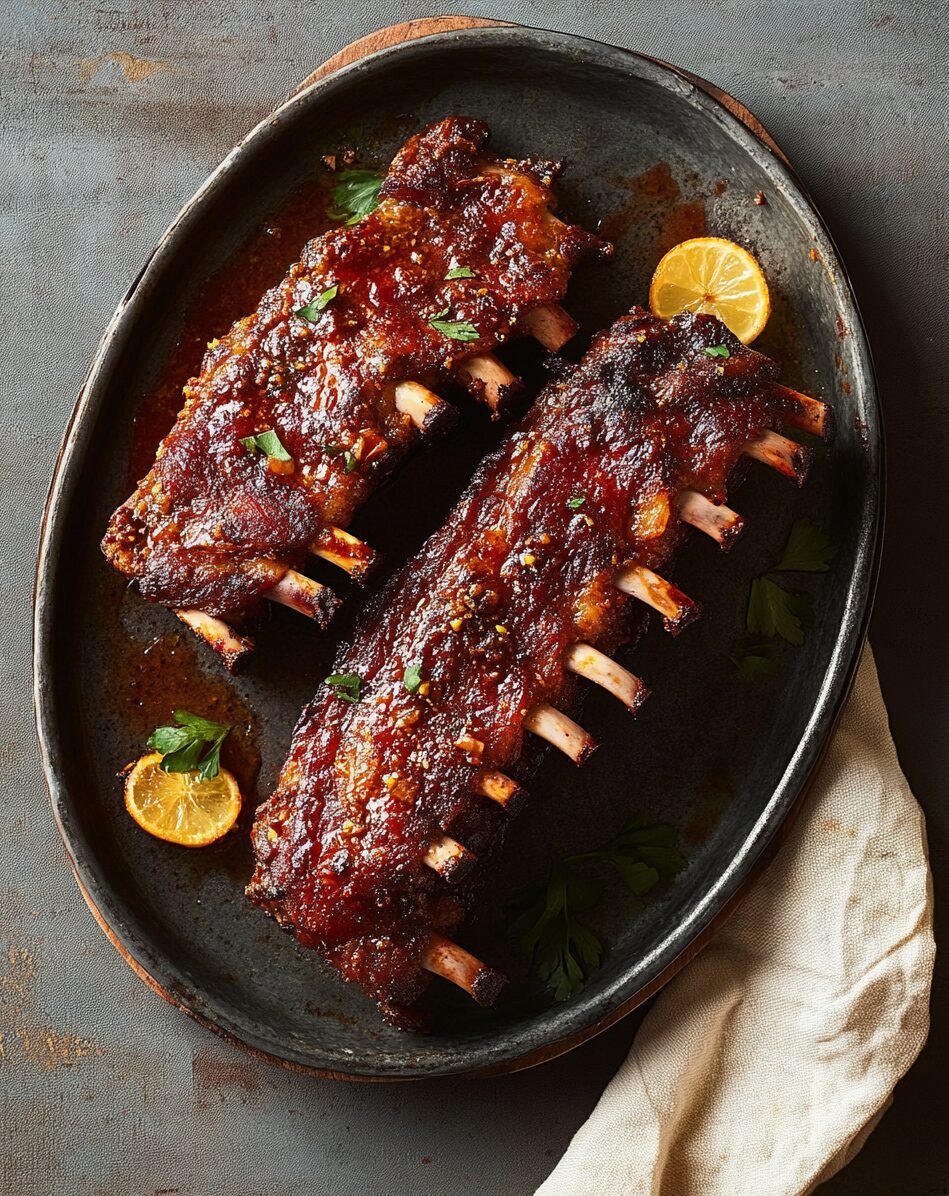Slow Cooker Baby Back Ribs are the ultimate comfort food for any occasion. With a blend of smoky, sweet, and spicy flavors, these ribs are cooked to perfection in your slow cooker. The magic happens as the ribs slow-cook in a savory barbecue sauce, tenderizing the meat to create fall-off-the-bone goodness. This recipe is so easy and perfect for busy weeknights or weekend cookouts.
Whether you’re a seasoned home chef or a beginner, these slow-cooked baby back ribs are foolproof. They’re ideal for serving at family gatherings, cookouts, or casual dinner parties. The minimal prep time and hands-off cooking allow you to spend more time with your guests or just relax while the ribs cook themselves. Enjoy the delicious results with some of your favorite sides!
Full Recipe:
Ingredients:
- 2 racks baby back ribs
- 1 cup barbecue sauce
- 1/4 cup apple cider vinegar
- 2 tablespoons brown sugar
- 1 tablespoon smoked paprika
- 1 teaspoon garlic powder
- 1 teaspoon onion powder
- 1/2 teaspoon black pepper
- 1/2 teaspoon salt
- 1/2 teaspoon cayenne pepper (optional)
- 1/2 teaspoon dried thyme
Directions:
- Remove the membrane from the ribs and pat them dry with paper towels.
- In a small bowl, mix together the brown sugar, smoked paprika, garlic powder, onion powder, black pepper, salt, cayenne, and dried thyme.
- Rub the spice mix generously over both sides of the ribs.
- Place the ribs in the slow cooker, standing upright if necessary.
- In a small bowl, combine the barbecue sauce and apple cider vinegar. Pour over the ribs.
- Cover and cook on low for 6-7 hours, or until the ribs are tender and cooked through.
- Once done, remove the ribs from the slow cooker, brush with additional barbecue sauce if desired, and serve.
Prep Time: 15 minutes | Cooking Time: 6-7 hours | Total Time: 6 hours 15 minutes | Kcal: 400 per serving | Servings: 4
History of Baby Back Ribs:
Baby back ribs, also known as back ribs or loin ribs, are a popular cut of pork that come from the upper part of the pig’s ribcage, located near the spine. They are called “baby” because they are shorter and more tender than spare ribs, which come from the belly side of the pig. This cut has been a staple in American barbecue culture for decades, often served at cookouts, barbecues, and family gatherings.
The history of barbecue in the United States is rich and diverse, originating from the early colonization of the country, with cooking methods rooted in Native American, African, and European traditions. Slow-cooked pork ribs became a central part of Southern barbecue cuisine, where different regions put their spin on the preparation. In recent years, baby back ribs have become an iconic dish, especially with the rise of slow-cooking techniques like the one used in this recipe.
Tips for Perfect Slow Cooker Baby Back Ribs:
- Remove the Membrane:
One of the most important steps for tender, juicy ribs is to remove the silver skin (the membrane) from the back of the ribs. This membrane can be tough and prevent the seasoning and barbecue sauce from fully penetrating the meat, so removing it is key to achieving that melt-in-your-mouth texture. - Season Generously:
Baby back ribs have a delicate flavor that pairs wonderfully with bold seasonings. The dry rub in this recipe combines smoky paprika, garlic, onion powder, and a touch of cayenne for some heat. Feel free to adjust the spices based on your preference—add more sugar for sweetness or more cayenne for a kick! - Use Your Favorite Barbecue Sauce:
The barbecue sauce you choose can make all the difference. Whether you prefer sweet, tangy, or spicy, make sure to use a sauce that complements the seasoning of the ribs. You can even make your own homemade BBQ sauce if you’re looking for something extra special. - Don’t Overcrowd the Slow Cooker:
If you’re cooking a large batch of ribs, make sure not to overcrowd the slow cooker. For the best results, it’s better to cook the ribs in two batches than to cram them in and risk uneven cooking. The ribs should be able to stand upright or fit snugly without being squished. - Baste with Extra Sauce:
After cooking, for an even juicier result, brush the ribs with an additional layer of barbecue sauce. This will give the ribs a glossy, flavorful finish and enhance their overall taste.
Serving Suggestions:
Slow Cooker Baby Back Ribs are a perfect main dish for a variety of occasions. Here are a few ideas to make the meal complete:
- Classic Sides: Serve your ribs with traditional barbecue sides like coleslaw, cornbread, baked beans, or potato salad.
- Grilled Veggies: Pair your ribs with some grilled vegetables such as asparagus, zucchini, or corn on the cob to add a fresh, healthy element to the meal.
- Sweet Potatoes: Roasted or mashed sweet potatoes complement the savory flavor of the ribs and add a touch of sweetness.
- Corn on the Cob: A classic BBQ side that pairs beautifully with tender, saucy ribs.
Substitutions & Variations:
- Spice Level: If you prefer a spicier kick, try adding more cayenne pepper or even some chopped jalapeños to the spice rub. For a milder flavor, you can reduce or omit the cayenne.
- Vegetarian Option: If you’re looking for a plant-based alternative, try using jackfruit or a plant-based rib alternative. These can be seasoned and slow-cooked in the same way for a delicious vegetarian BBQ experience.
- Sugar-Free Option: For those watching their sugar intake, you can substitute the brown sugar with a sugar substitute, such as stevia or monk fruit sweetener, for a healthier version.
Why Use a Slow Cooker?
The slow cooker is perfect for ribs because it allows the meat to cook slowly and evenly, breaking down the tough connective tissues in the ribs and making them incredibly tender. This method also locks in moisture, ensuring your ribs won’t dry out while cooking. Plus, the slow cooker allows you to set it and forget it—no need to watch over the ribs constantly, which is ideal for busy days or gatherings. You’ll love how the flavors develop and meld together over several hours!
FAQ:
Can I cook ribs on high instead of low?
While it’s possible to cook ribs on high in the slow cooker, the low setting gives a better result by allowing the meat to cook more slowly and tenderize thoroughly. If you’re in a rush, cooking on high will take about 4 hours, but for the most tender ribs, slow cooking on low is recommended.
Can I finish the ribs on the grill?
Yes! If you want to add a grilled flavor to your slow-cooked ribs, preheat your grill to medium-high heat and brush the ribs with additional barbecue sauce. Grill them for about 5-10 minutes per side to caramelize the sauce and give the ribs a smoky finish.
How to Store Leftover Slow Cooker Baby Back Ribs:
If you’re lucky enough to have leftovers, you can store them for later! Here’s how:
- Refrigerating:
Once the ribs have cooled, place them in an airtight container and store them in the refrigerator. They will stay fresh for up to 3-4 days. - Freezing:
For longer storage, you can freeze the ribs. Wrap them tightly in aluminum foil or plastic wrap, then place them in a freezer-safe bag or container. They can be frozen for up to 3 months. To reheat, thaw the ribs in the refrigerator overnight and then reheat them in the oven at 350°F for about 20-30 minutes. - Reheating:
To keep the ribs moist, reheat them gently in the oven, covered with foil, with a bit of BBQ sauce to prevent them from drying out. You can also reheat them in a slow cooker for an hour or so on low heat.
Conclusion:
This Slow Cooker Baby Back Ribs recipe is the ultimate way to enjoy tender, flavorful ribs without the need for a grill. The low and slow cooking process creates a deliciously tender texture, while the BBQ sauce infuses the meat with rich flavors. Whether you’re preparing them for a family dinner, a BBQ party, or just because you love ribs, this recipe is sure to become a favorite in your kitchen.
Don’t forget to experiment with different spices, sauces, and sides to make it your own. The versatility of this dish makes it perfect for a variety of occasions, from casual weeknight dinners to holiday feasts.






